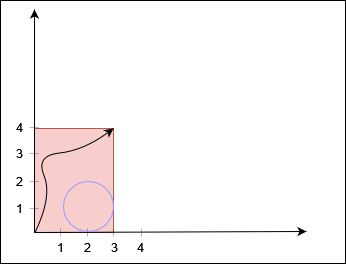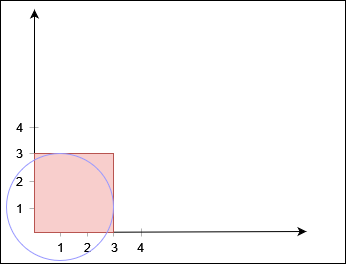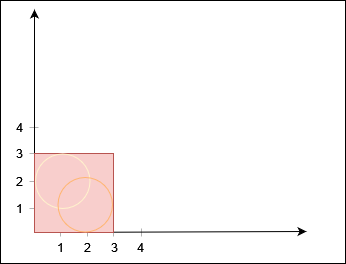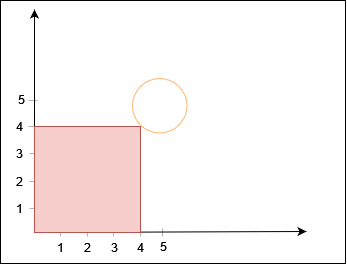LeetCode in Kotlin
3235. Check if the Rectangle Corner Is Reachable
Hard
You are given two positive integers X and Y, and a 2D array circles, where circles[i] = [xi, yi, ri] denotes a circle with center at (xi, yi) and radius ri.
There is a rectangle in the coordinate plane with its bottom left corner at the origin and top right corner at the coordinate (X, Y). You need to check whether there is a path from the bottom left corner to the top right corner such that the entire path lies inside the rectangle, does not touch or lie inside any circle, and touches the rectangle only at the two corners.
Return true if such a path exists, and false otherwise.
Example 1:
Input: X = 3, Y = 4, circles = [[2,1,1]]
Output: true
Explanation:

The black curve shows a possible path between (0, 0) and (3, 4).
Example 2:
Input: X = 3, Y = 3, circles = [[1,1,2]]
Output: false
Explanation:

No path exists from (0, 0) to (3, 3).
Example 3:
Input: X = 3, Y = 3, circles = [[2,1,1],[1,2,1]]
Output: false
Explanation:

No path exists from (0, 0) to (3, 3).
Example 4:
Input: X = 4, Y = 4, circles = [[5,5,1]]
Output: true
Explanation:

Constraints:
3 <= X, Y <= 1091 <= circles.length <= 1000circles[i].length == 31 <= xi, yi, ri <= 109
Solution
import kotlin.math.pow
import kotlin.math.sqrt
class Solution {
fun canReachCorner(x: Int, y: Int, circles: Array<IntArray>): Boolean {
val n = circles.size
val ds = DisjointSet(n + 5)
// Special nodes for boundaries
val leftBoundary = n + 3
val topBoundary = n
val rightBoundary = n + 1
val bottomBoundary = n + 2
var i = 0
for (it in circles) {
val xi = it[0]
val yi = it[1]
val ri = it[2]
if (yi - ri >= y || xi - ri >= x) {
continue
}
if (((xi > (x + y) || yi > y) && (xi > x || yi > x + y))) {
continue
}
if (xi <= ri) {
ds.dsu(i, leftBoundary)
}
if (yi <= ri) {
ds.dsu(i, topBoundary)
}
if (x - xi <= ri) {
ds.dsu(i, rightBoundary)
}
if (y - yi <= ri) {
ds.dsu(i, bottomBoundary)
}
i++
}
// Union circles that overlap
i = 0
while (i < n) {
val x1 = circles[i][0]
val y1 = circles[i][1]
val r1 = circles[i][2]
if (y1 - r1 >= y || x1 - r1 >= x) {
i++
continue
}
if (((x1 > (x + y) || y1 > y) && (x1 > x || y1 > x + y))) {
i++
continue
}
for (j in i + 1 until n) {
val x2 = circles[j][0]
val y2 = circles[j][1]
val r2 = circles[j][2]
val dist = sqrt(
(x1 - x2.toDouble()).pow(2.0) + (y1 - y2.toDouble()).pow(2.0),
)
if (dist <= (r1 + r2)) {
ds.dsu(i, j)
}
}
i++
}
// Check if left is connected to right or top is connected to bottom
if (ds.findUpar(leftBoundary) == ds.findUpar(rightBoundary) ||
ds.findUpar(leftBoundary) == ds.findUpar(topBoundary)
) {
return false
}
return (
ds.findUpar(bottomBoundary) != ds.findUpar(rightBoundary) &&
ds.findUpar(bottomBoundary) != ds.findUpar(topBoundary)
)
}
private class DisjointSet(n: Int) {
private val parent: IntArray
private val size = IntArray(n + 1)
init {
size.fill(1)
parent = IntArray(n + 1)
for (i in 0..n) {
parent[i] = i
}
}
fun findUpar(u: Int): Int {
if (u == parent[u]) {
return u
}
parent[u] = findUpar(parent[u])
return parent[u]
}
fun dsu(u: Int, v: Int) {
val ulpu = findUpar(u)
val ulpv = findUpar(v)
if (ulpv == ulpu) {
return
}
if (size[ulpu] < size[ulpv]) {
parent[ulpu] = ulpv
size[ulpv] += size[ulpu]
} else {
parent[ulpv] = ulpu
size[ulpu] += size[ulpv]
}
}
}
}

